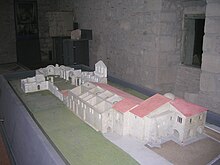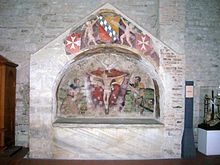Abbey of Santissima Trinità di Venosa
The Abbazia della Santissima Trinità (Abbey of the Most Holy Trinity) is a Roman Catholic abbey near Venosa , in the vulture area of the province of Potenza in the southern Italian region of Basilicata . The architecture of the abbey shows Roman , Lombard and Norman influences. The abbey complex is part of the Venosa Archaeological Park and is located about 1.5 kilometers northeast of the city. It belongs to the Roman Catholic diocese Melfi-Rapolla-Venosa and consists of the old church, remains of the monastery buildings and an unfinished new church. The complex was declared a national monument by royal decree of November 20, 1897. Today it is no longer a monastery, but is used by the Trinitarian order .
history
The start of construction is unknown, some elements could go back to the 8th century. A founding date 954 is given in the forgery Chronicon Cavense of the forger, scholar and priest Francesco Maria Pratilli (1689–1763). After the Council of Melfi in 1059, the church was consecrated on August 17th, 1059 by Nicholas II and on August 25th, by a papal privilege, it was directly subordinate to the Roman Church, to which one gold ounce was to be paid as interest endowed with the right to freely elect an abbot and assured the elected consecration by the Pope. In this document, Count Drogo is named as the founder. His successor, Humfred, was also a patron of the monastery. in which he was also buried. The number of monks rose under Abbot Berengar , who had come from Saint-Évroult to the Norman-ruled Apulia and was consecrated by Alexander II , after 1066 from 20 to 100. Robert Guiscard , who at the church assembly in Melfi as Duke of Apulia and Calabria had been established and Pope Nicholas II took the oath of allegiance there, made the abbey the religious center of his dominion and the memoria of the Hauteville family.
The old church stands on the remains of a Roman building from the Roman Empire , possibly a domus . This shows traces of earlier settlement in republican times as well as late classical changes. Some of the walls of the church are placed directly on the mosaic floors of the old building.
To the south of the church are the remains of an early Christian basilica, possibly dating to the late fifth or early sixth century. It had a hexagonal baptismal font in a three-pass apse .
In 1297, on the instructions of Pope Boniface VIII, the abbey passed from the Benedictines to the Johanniter .
Old church
The Romanesque portal of the church is flanked by two stone lions. The church has the typical plan of an early Christian basilica with a narthex , an atrium , a wide central nave and side aisles, a transept and a semicircular apse with ambulatory . Changes were made by the Lombards in the 10th century and by the Normans between the 11th and 13th centuries. There are also two Corinthian columns in the nave .
In the right aisle is the Hauteville tomb ( La tomba degli Altavilla in Italian ), in which five members of the Norman Hauteville family are buried: Wilhelm Eisenarm (1010-1046), his brothers Drogo (around 1010 - 1051) and Humfred (around 1010 - 1057) as well as their half-brothers Robert Guiscard (around 1015 - 1085) and Wilhelm (around 1027 - 1080). Their bones were exhumed from their individual graves in the middle of the 16th century by Agostino Gorizio Barba da Novara, Vogt of the Order of Malta, and reburied here.
In the left aisle is the grave of Alberada von Buonalbergo , Robert Guiscard's first wife . Alberada's son with Guiscard, Bohemond of Taranto , an important participant in the First Crusade , died in 1111 near Canosa di Puglia and is buried there. The Latin inscription on Alberada's tomb reads:
"GVISCARDI CONIVX ABERADA HAC CONDITVR ARCA / SI GENITVM QVÆRES HVNC CANVSINVS HABET"
“Aberada, wife of Guiscard, lies in this tomb; if you are looking for her son: Canosa has him. "
L'Incompiuta
Construction of the unfinished L'Incompiuta began in the last quarter of the 11th century using building materials from structures from different eras, including Roman, Lombard and Jewish buildings. The floor plan is unusual for Italy and French in concept, it shows similarities with the cathedrals of Aversa and Acerenza .
photos
literature
- Walther Holtzmann : Italia Pontificia IX: Samnium - Apulia - Lucania . Berlin 1962, pp. 490-494.
- Léon-Robert Ménager : Les fondations monastiques de Robert Guiscard, duc de Pouille et de Calabre . In: Sources and research from Italian archives and libraries 39, 1959, pp. 1–116; here p. 22–57: II. La ss.ma Trinità di Venosa and p. 82–116: Actes relatifs à la Trinité de Venosa rapportés dans les notices de Prignano ( online ).
- Monasticon Italiae III: Puglia e Basilicata a cura di Giovanni Lunardi, Hubert Houben , Giovanni Spinelli. Prefazione di Cosimo Damiano Fonseca . Cesena 1986 (Monasticon Italiae. Repertorio topo-bibliografico dei monasteri italiani, 3) pp. 202f. No. 96.
- Corrado Bozzoni: Saggi di architettura medievale: la Trinità di Venosa, il Duomo di Atri . Roma: Università degli studi, Istituto di fondamenti dell'architettura 1979.
- Emanuele Lauridia: La chiesa della SS.Trinità di Venosa: monumento nazionale dal 20-XI-1897. Arti grafiche Laterza, Bari 1961.
- Antonio Vaccaro: Guida di Venosa . Edizioni Osanna 1998.
See also
Web links
- Site of the Venosa municipality to the monastery
- Publications of Hubert Houben Venosa in the OPAC Regesta Imperii
Remarks
- ^ Luigi Ranieri: Basilicata . Torino: UTET 1972, p. 289
- ↑ a b c Mariarosaria Salvatore: Venosa, un parco archeologico ed un museo: come e perché . Taranto: Scorpione 1984.
- ^ A b Rosa Villani: Età angioina: La Chiesa della SS. Trinità a Venosa ( Memento of May 3, 2014 in the Internet Archive ) (Italian). Consiglio Regionale di Basilicata 1999: Cultura / Arte.
- ↑ Giacomo Cirsone. La basilic della SS Trinità di Venosa dalla tarda Antichità all'Età Moderna (II parte), in: La Capitanata , semestrale della Library Provinciale di Foggia. XLX 2012, (27): 99–141 (Italian) ( Memento from May 3, 2014 in the Internet Archive )
- ^ Walther Holtzmann : Italia Pontificia IX: Samnium - Apulia - Lucania . Berlin 1962, p. 493 No. 4
- ↑ However, the tomb has not been preserved.
- ^ Walther Holtzmann : Italia Pontificia IX: Samnium - Apulia - Lucania . Berlin 1962, p. 493 No. 5.
- ^ Paul Fridolin Kehr : Italia Pontificia VIII: Regnum Normannorum - Campania . Berlin 1935, pp. 11-12 No. 14 *, 15, 16.
- ↑ a b Giacomo Cirsone: La basilica della SS. Trinità di Venosa dalla Tarda Antichità al Medioevo. La Capitanata , Semestrale della Biblioteca Provinciale di Foggia. XLVIII 2011 (25): 125–180 ( Memento of May 3, 2014 in the Internet Archive ) in Italian.
- ↑ Giacomo Cirsone (2013): La basilica della SS. Trinità di Venosa dalla Tarda Antichità all'Età Moderna (III parte) (Italian). La Capitanata , Semestrale della Biblioteca Provinciale di Foggia. LI (28): 113-134. ( Memento from May 3, 2014 in the Internet Archive )
Coordinates: 40 ° 58 ′ 10.2 ″ N , 15 ° 49 ′ 39.4 ″ E











